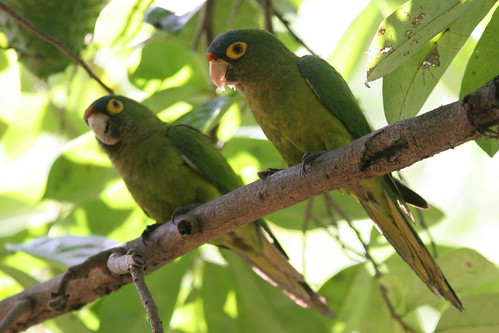 Vocal Imitation in Parrots Allows Addressing of Specific Individuals in a Dynamic Communication Network. Image by Emily HoyerParrots mimic the calls of others in order to "start a conversation", according to scientists.
Vocal Imitation in Parrots Allows Addressing of Specific Individuals in a Dynamic Communication Network. Image by Emily HoyerParrots mimic the calls of others in order to "start a conversation", according to scientists.
Researchers observed the behaviour of orange-fronted conures: parakeets found from western Mexico to Costa Rica.
The scientists found that the birds responded faster and more frequently when other birds imitated their calls.
The authors suggest that the parrots may have developed their impressive mimicry to be able to address individuals within a flock.
The findings, by Dr Thorsten Balsby from the University of Aarhus, Denmark, and colleagues from the University of Copenhagen, Denmark, are published in the journal PLOS One.
According to Mr Balsby, the research was inspired by a previous study that suggested that spectacled parrotlets (Forpus conspicillatus) use different calls to effectively "name" individuals in a flock.
But in the wild the orange-fronted conures (Aratinga canicularis) live in what researchers describe as "network environments" - dynamic flocks with multiple birds calling simultaneously.
"Such a naming system would probably not work, as each individual potentially encounters hundreds of birds on a weekly basis," explained Dr Balsby.
To distinguish themselves in this noisy network, each parakeet has an individual "contact call".
Observing birds both in the forest and in lab environments, the team found the birds responded faster and more frequently when their own contact call was mimicked by another bird.
Dr Balsby said he was "amazed" that the parakeets could imitate the "relatively subtle differences in the contact calls".
Birds of a feather
He explained that the ever-changing flocks, which constantly fuse with and separate from other groups, could be the driving force behind this adaptation.
"Many species of parrots live part of the year in flocks," said Dr Balsby. "Living in flocks may be challenging and require a flexible vocalisation system."
"The vocal imitation of orange-fronted conures is probably tightly linked to the fission-fusion flock dynamics that results in frequent encounters and interactions with many different individuals."
But as well as imitating others in order to address them, Dr Balsby suggests that the mimicry could communicate messages between flocks.
"In natural interactions, orange-fronted conures continue to imitate each other after they have established contact," he explained.
"The function of these prolonged imitative interactions is not known yet but may be related to some kind of negotiation regarding the decision to make a flock fuse with another flock."